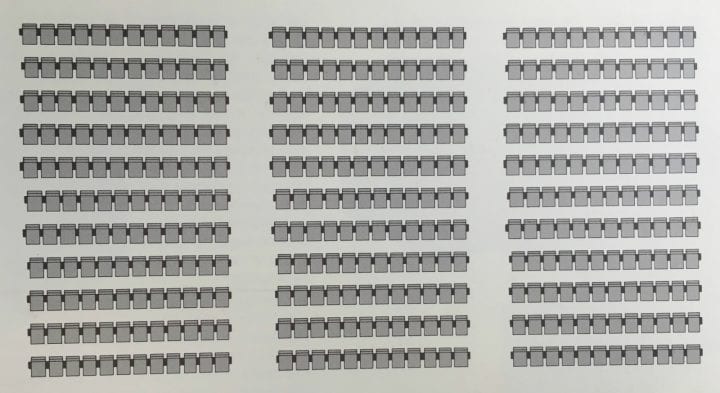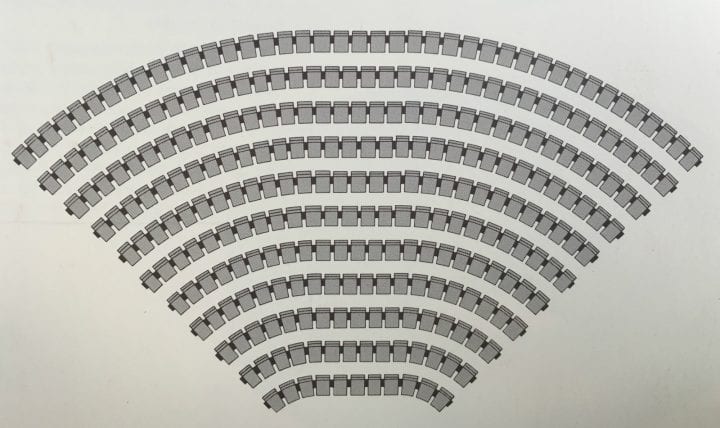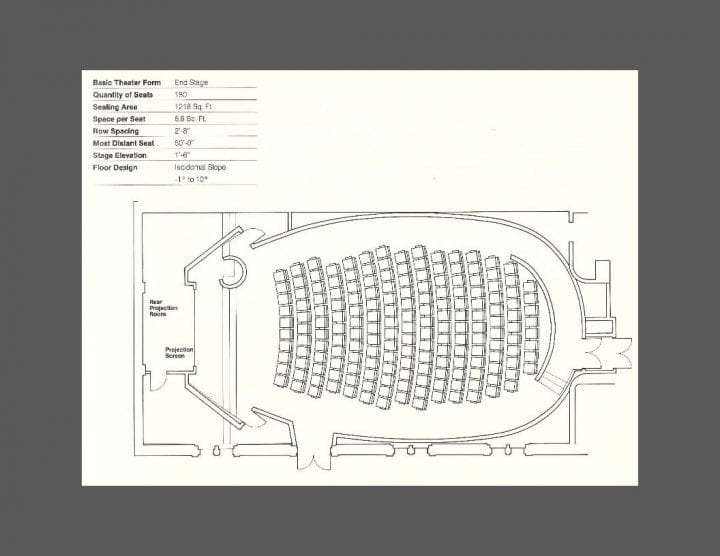Running out of ideas for your next auditorium project? Check out these auditorium design examples with seating dimensions to keep the creative juices flowing.

Tackling an auditorium and fixed seating project?
Great! We’re here to help with your auditorium plan.
Whether you’re looking for dimensions for an auditorium seating plan and seat spacing or an introduction to auditorium layout, this guide will help you get started.
Let’s get down to the details!
Select your seating arrangement
Whether you’re designing a lecture hall, an open arena, or an elaborate theater adorned with a proscenium arch, the first thing to consider is your seating arrangements.
There are two basic seating layouts you can consider for an auditorium:
Multiple aisle: This seating arrangement offers a formal setup, suitable for lecture halls and business conferences. though the seat count can vary, the typical limit is a maximum of 14-16 chairs per row.

Multiple aisle seating (Source)
Continental: This seating arrangement makes good use of space and is a preferred choice for open space auditoriums and amphitheaters. Having all seats turned toward the central arena in a concave fashion helps establish greater intimacy between the performers and the viewers.

Continental seating (Source)
Decide on the best "form" for your auditorium plan
“Form” is the overall shape your theater or auditorium will take, depending on what kind of relationship you want there to be between the spectators and performers. It’s determined by the planned use of the space and each form has its pros and cons.
Here’s a quick summary:
End stage: The end stage utilizes space effectively and is an excellent choice for lecture halls and film presentations. The seating arrangement is usually multiple aisle—ideal if you need to create an auditorium plan for small spaces. However, the end stage is not the most desired form if you want to create an intimate experience between performers and spectators.
Here’s an example of the end-stage form with dimensions:
Quantity of seats: 180
Seating area: 1218 sq. ft.
Space per seat: 6.8 sq. ft.
Row spacing: 2’ 8”
Most distant seat: 50′ 0″
Stage elevation: 1’ 6″
Floor design: Iscidomal slope, 1°-10°

Example of end stage (Source)
Wide fan: The wide fan layout is great for bringing viewers closer to performers but it limits usage to mostly speech-related activities. This auditorium form works if you plan the seating arrangement so that none of the spectators has a difficult time viewing or hearing the performers.
Here’s an example of the wide fan form with dimensions:
Quantity of seats: 154
Seating area: 1930 sq. ft.
Space per seat: 12.4 sq. ft.
Row spacing: 4’ 0”
Most distant seat: 35′ 0″
Stage elevation: 12″
Floor design: Risers, 12″

Example of wide fan (Source)
3/4 arena: This form is typically used for open space theaters and is based on the continental seating arrangement. It closely resembles amphitheaters and is one of the oldest auditorium designs, dating back to the Greek era. The form is useful for musical concerts and plays, as it offers great sight and aural clarity to the audience.
Here’s an example of the 3/4 arena with dimensions:
Quantity of seats: 56
Seating area: 622 sq. ft.
Space per seat: 11.1 sq. ft.
Row spacing: 3' 3"
Most distant seat: 32' 0"
Stage elevation: None
Floor design: Risers, 4"

Example of 3/4 stage (Source)
Conclusion & next steps
If you have no experience designing an auditorium space and you’re asking, “What are the basic next steps to take?” then we’ll leave you with a quote from Mario Pimenta, who is competent in architecture and well versed in auditorium layouts:
Figure out the desired capacity of the room—how many seats are required?
Assign a generic space requirement for each seat—this varies—but ten square feet per chair would probably be adequate for most layouts. This will allow for a general idea of the size of the room.
Consult local egress codes to determine the required number/locations of exits, aisle locations and clear width, and back-to-back row spacing.
Determine what fire codes are in effect. In almost every case the seating—as well as the materials used in an assembly space—must comply with certain fire codes.
Finally, sightline studies should be conducted and these studies along with compliance of egress codes will, to a great extent, determine the seating layout. During the planning stage it is critical to seek the assistance of a local licensed architect and, depending on the size and complexity of the room, consultation with a theater consultant may be appropriate.
If you’re an architect looking to purchase design software, we recommend checking out Capterra’s architecture software directory. You’ll find a list of more than 80 products, along with their reviews, ratings, and more.
Finally, let us know in the comments below if you have any major takeaways from—or input for—this article!